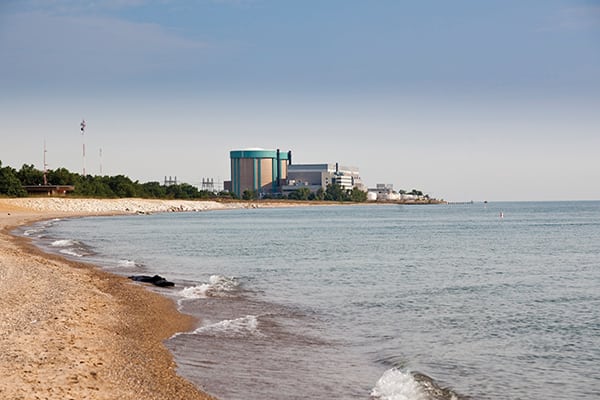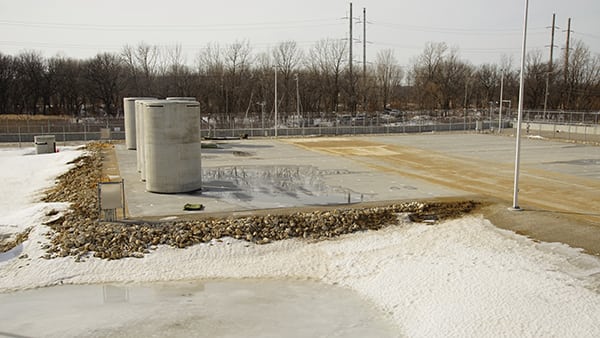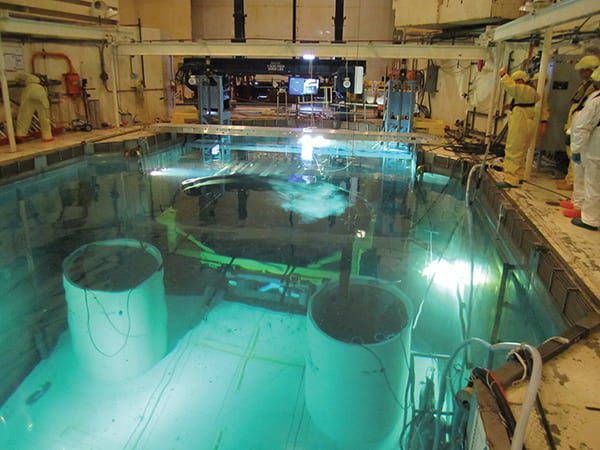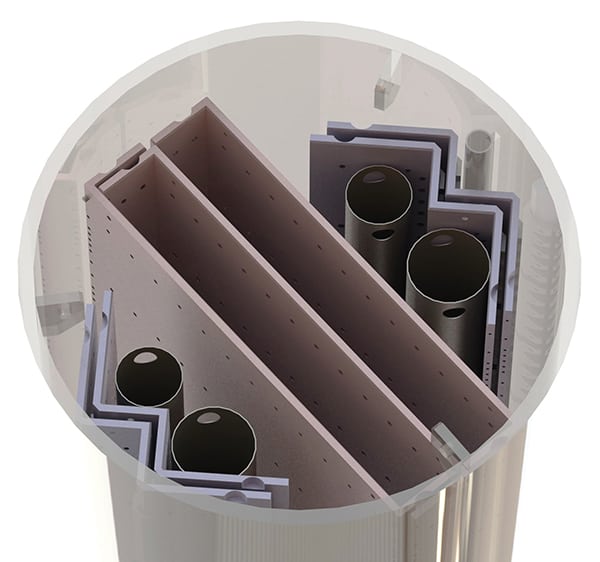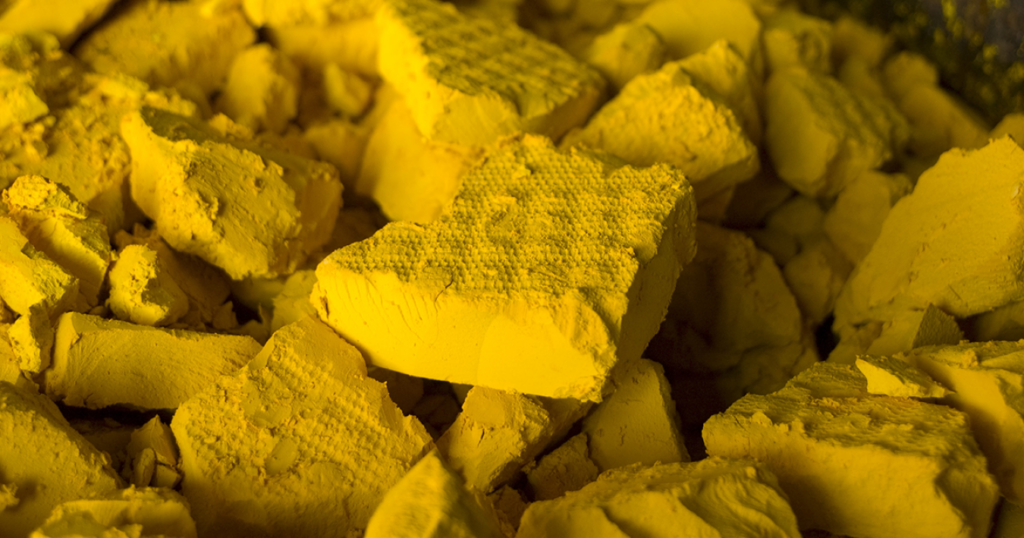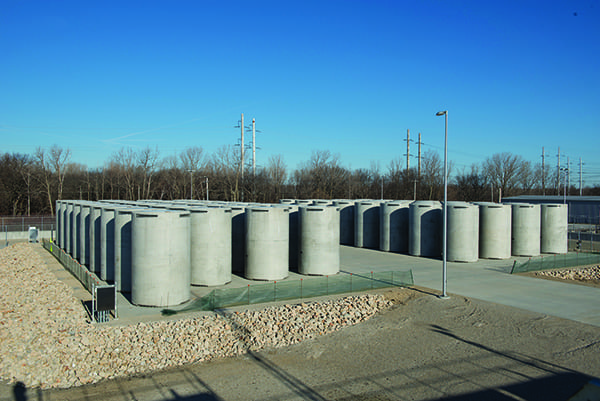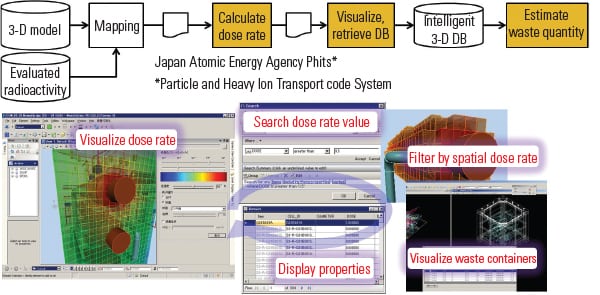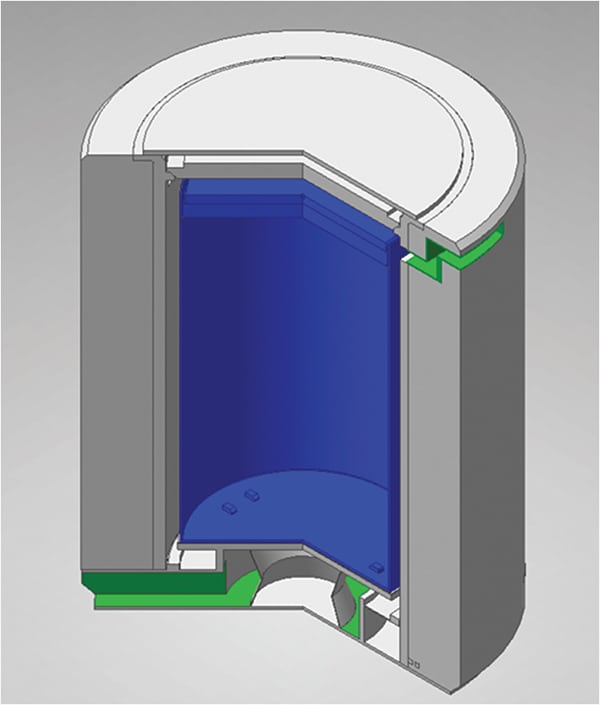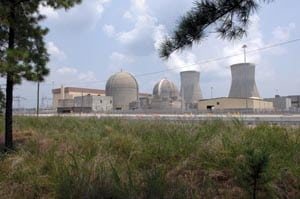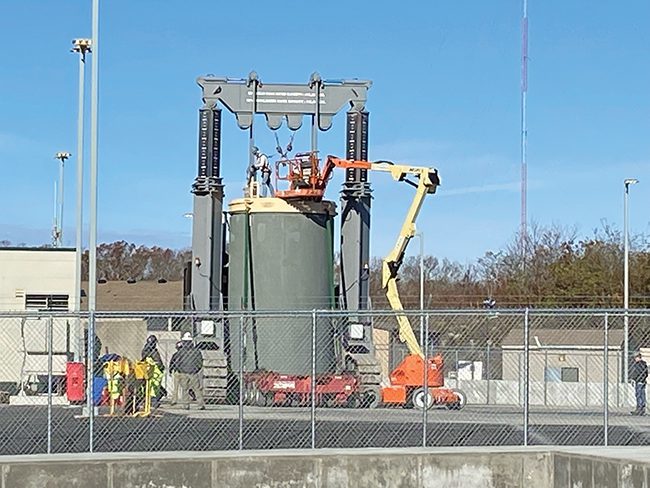Although the size and longer operating life of the Zion Nuclear Power Station resulted in greater activation of the reactor components compared to previous projects, license transfer and cold-cutting methods being used to segment the reactor vessels and internals have helped cut 10 years off the original schedule.
The decommissioning of nuclear plants has developed into a mature industry in the U.S. It started in the 1960s with the dismantling of low-power prototype and test reactors originally built to demonstrate nuclear power feasibility. Large-scale decommissioning projects began in the 1980s with Shippingport, followed by several others in the next decade.
The visual markers of a decommissioned site that still remain typically include support buildings and security fences surrounding large Nuclear Regulatory Commission (NRC)-approved casks containing spent fuel located inside the site’s independent spent fuel storage installation (ISFSI). The ISFSIs have become individual de facto repositories resulting from the absence of a geologic repository, such as the proposed Yucca Mountain site (see “The U.S. Spent Nuclear Fuel Policy: Road to Nowhere” in the May 2010 issue and “The U.S. Spent Nuclear Fuel Policy, Part 2: Playing Hardball” in the November 2011 issue of POWER online at powermag.com).
Zion Decommissioning Strategy
After more than 20 years of operation, Unit 2 of the Zion plant, located on the shore of Lake Michigan, was prematurely shut down on Sept. 19, 1996, followed by Unit 1 on Feb. 21, 1997. Operations were terminated on Jan. 15, 1998, and were officially confirmed with a permanent cessation of operations letter submitted on Feb. 13, 1998. Commonwealth Edison, owner of the plant at the time, concluded that the continued operation of Zion (Figure 1) was not financially feasible, removed the plant from service, and started the decommissioning process. (For more on the procedure, see sidebar “Decommissioning Requirements, Licensee Actions, and Submittals.”)
| Decommissioning Requirements, Licensee Actions, and SubmittalsThe decommissioning requirements for licensed nuclear plants are found in Title 10 of the Code of Federal Regulations. The regulations address decommissioning, planning needs, timing, funding methods, and environmental review requirements. Here are some of the key steps:■ Within 30 days of permanent shutdown, the licensee must notify the Nuclear Regulatory Commission (NRC) by written certification, which starts the decommissioning clock.■ Upon completion of fuel removal, the licensee submits certification of completion and is no longer permitted to operate the reactor or put fuel back in the vessel. At that point, the NRC reduces the annual license fee and initiates transfer of the plant to the decommissioning program.■ Within two years of permanent shutdown, a post-shutdown decommissioning activities report must be submitted.
■ An annual report on the decommissioning funds must be submitted each year by Mar. 31. ■ Within 60 years, the licensee must complete the decommissioning by dismantling and decontaminating the plant. ■ A license termination plan must be submitted at least two years before termination of the license. ■ The licensee must conduct final status surveys. ■ As the final step, the NRC will review the licensee’s submittal of final status radiological survey reports and the licensee’s request for license termination. The NRC terminates the license if all criteria are met. |
After the Zion fuel was transferred to the spent fuel pool, the certification of fuel transfer was submitted to the NRC on Mar. 9, 1998. That was followed by the post-shutdown decommissioning activities report, site-specific cost estimate, and fuel management plan on Feb. 14, 2000. Submittal of the license termination plan is scheduled to occur in 2015, with a final site survey and license reduction to the ISFSI expected during 2018.
Originally, the Zion units were placed in SAFSTOR status, one of the NRC’s approved decommissioning strategies. With this option, the facility is maintained and monitored in a condition that allows the radioactivity to decay; afterwards, it is dismantled and the property is decontaminated. The Zion reactors were unique due to the longer operating life of both units, resulting in greater activation of the reactor vessels and internals. Field operations were not expected to start until 2015, and complete site restoration was planned for 2028 as reported in the post-shutdown decommissioning activities report submitted on Feb. 14, 2000.
Change in Plans
On Jan. 25, 2008, Exelon Generation Co. LLC requested NRC approval to transfer its possession-only license covering storage and decommissioning activities, management authorities, and the decommissioning trust fund to ZionSolutions LLC—a license-stewardship company created for the safe cleanup and environmental restoration of the Zion site—a subsidiary of EnergySolutions LLC. POWER interviewed John Sauger, vice president and general manager of the ZionSolutions project, about this historic license transfer and to obtain a project update.
Sauger described how a utility’s primary focus is on the plant—considered to be an asset—and operating it safely, cost effectively, and efficiently. But utilities are not decommissioning companies, so when they are looking at retiring an asset from service, it becomes a liability, a risk to the corporation.
“What is unique about the Zion decommissioning is that EnergySolutions entered into an agreement with Exelon where we took all the risk of decommissioning. We took the whole thing on. It is no longer Exelon’s responsibility,” Sauger said.
On Sept. 1, 2010, the possession-only license was transferred from Exelon to ZionSolutions to decommission the site. In so doing, ZionSolutions became the NRC licensee. It was the first time this had been done in the U.S.
Federal law mandates that the spent fuel must remain on site. As part of the decommissioning process, ZionSolutions has constructed a dry cask ISFSI where the spent fuel will be stored (Figure 2). Once decommissioning is completed, all applicable licenses and property will be transferred back to Exelon, which will retain ownership of the 200+-acre site.
SAFSTOR to DECON
The license stewardship program developed by ZionSolutions accelerates the decommissioning of nuclear power plants. Under SAFSTOR, the asset sits for 40 to 60 years and money still needs to be invested to maintain the structures, equipment, and fuel pools. DECON—another NRC-approved decommissioning strategy—involves the immediate dismantling of equipment, structures, and portions of the facility containing radioactive contaminants. Using this method, materials are removed or decontaminated to a level that permits release of the property and termination of the NRC license.
“When ZionSolutions took the license, we said our best bet is to switch from SAFSTOR to immediate decontamination and decommissioning, and take the plant down. So the savings you see in years is from changing the approach from SAFSTOR to DECON,” Sauger said.
As a result of this accelerated schedule, decommissioning is projected for completion in 2018, 10 years sooner than the original 2028 end date. Although there are many factors that affect reactor decommissioning costs—the timing and sequence of the various stages of the program, type of reactor, location, radioactive waste burial costs, and plans for spent fuel storage—the NRC estimates between $280 million and $612 million for a typical reactor. No additional funds from Illinois electric ratepayers are funding the project. Sauger added that there is no recourse to seek additional funds.
The Zion decommissioning activities have been divided into three phases; phases 1 and 2 are currently in progress. Phase 1 involves transferring spent fuel from the fuel pool to dry storage. During this process, 2,226 fuel assemblies will be placed in dry storage in 61 canisters at the ISFSI. Phase 2 includes license termination. This phase requires equipment to be removed, including components such as the reactor vessel, valves, piping, turbines, generators, condensers, pumps, motors, and transformers. Building dismantlement is also part of phase 2. Phase 3 includes grading and landscaping to restore the “non-rad” site.
Key non-radiological contaminants present at the site and still used to maintain existing site infrastructure might require remediation upon final dismantlement. Items such as asbestos, transformer cooling oil, lubricating oil, diesel fuel, gasoline, and other plant chemicals fall into this category.
ZionSolutions’ goal is to reduce post-operational removal of bulk radioactive material, such as the spent fuel, thereby transferring a significant amount of the radioactivity to the fuel pool and ISFSI. This is followed by the strategic segmentation and removal of reactor vessel internals (RVIs), and then the reactor vessel (RV) for waste classification and disposal.
Primary Deconstruction
In April 2011, ZionSolutions initiated physical work to extract concrete, rebar, and post-tensioned tendon sleeves from the Unit 2 containment building. The concrete extraction created an approximate 34 x 31 foot opening in the containment building wall to accommodate installation of the heavy lift rail system (HLRS). The HLRS is being used for mobilization and demobilization of the RV and RVI segmentation equipment, including large component removal of the steam generators, reactor coolant pumps, and pressurizer. Additional rail lines were constructed to assist with waste loading and transportation of these large, heavy items.
The RV (approximately 44 feet tall with an inside diameter of 14 feet) is constructed from low-carbon alloy steel for strength, lined with stainless steel cladding to protect the vessel from corrosion. The Unit 2 RV head was shipped as one piece to the EnergySolutions disposal site in Clive, Utah. The total weight of a packaged RV head was about 115 tons. It was transported on a 173-foot super-load 18-axle tractor/trailer combination rig with a push tractor to assist in ascending hills. The Clive disposal facility is located 70 miles west of Salt Lake City and is the U.S.’s largest and most comprehensively licensed commercial class A low-level radioactive waste disposal facility. The site’s remote location, low annual rainfall, and stable geology are some of the reasons why Clive is favorable for this type of material.
The Unit 1 head was size reduced using a hand-held torch prior to being shipped. The control rod shafts were cut using mechanical “lathe”-type cutting on Unit 1 based on lessons learned from Unit 2.
Prior to filling the RV with water to conduct RVI segmentation, the RV hot- and cold-leg piping connections had to be “cut and capped,” and verified leak free. The team designed a filling system to pump about 400,000 gallons of water from the refueling water storage tank to the Unit 2 reactor cavity. Filtration equipment was used to maintain water clarity within the cavity, and an underwater lighting system was also used. The dose goal for this effort was 5.528 rem, but work was completed with only 3.863 rem received.
The RVIs broadly consist of the upper and lower core support structures and internals. The upper internals package weighs around 110,200 pounds and is composed of an upper core plate, support columns, and control rod guide tube assemblies. Under the high-pressure and -temperature conditions of an operating reactor, these structures are needed to support the control rods, in-core instrumentation, and maintain alignment of the fuel assemblies.
The lower core internals weigh approximately 264,500 lb and include the core barrel, core baffles, lower core and bottom support plates, and supporting structures. The core barrel slides down inside the RV, contains the fuel assemblies, and directs coolant flow. It is a cylindrical shell 147.25 inches in diameter and 330.75 inches long. The core support casting is 18 inches thick and is welded to the bottom of the core barrel. The structure carries the weight of the fuel assemblies and distributes the coolant flow to the fuel assemblies. The 360-degree, full-circle thermal shield is located in the annular region between the core barrel and the RV wall, and protects the RV wall from excessive gamma heating and gamma/neutron radiation damage.
Tool and Machine Evolution
The tools and machines used for this project have been used successfully in nuclear facilities around the world since the early 1980s. Sauger commented on how the approach has evolved over time, from relying on “hot work” thermal applications to “cold cutting” by sawing and milling.
“Back in the 1990s, when we started decommissioning plants, the first reactor internals projects were done with plasma cutters. Call this Generation I. Did it work? Yes. But there were drawbacks to using plasma cutters. They destroyed the water clarity. The plasma would generate so much debris, and contamination would spread though the pool. So we learned from that and said we could do better,” he said.
Sauger reflected on Generation II—abrasive water-jet cutting—which was tested at Maine Yankee. There was improved water clarity, but it generated more greater-than-class-C (GTCC) waste.
“It was a step improvement, it was a much better process, but it was not where we wanted to be. Generation III, which is where we are at now, is the mechanical cutting, which is by far the best way to take care of the reactor internals—very little secondary waste and no issues with water clarity. This is a first-of-a-kind-approach for this type of reactor vessel and it is going according to plan,” said Sauger.
The first major underwater segmentation activities and removal of the RVIs were started on Mar. 5, 2012. The volume reduction station (VRS, Figure 3) cutting table is capable of supporting reactor components up to about 119,000 lb. It uses a circular milling saw and a reciprocating milling saw to segment the upper internals, upper and lower core plates, core barrel sections, and thermal shield sections. It can rotate 360 degrees and can move forward and back 36 inches to position the component for segmentation at a fixed saw position. The lower internals were initially segmented using three remotely operated, hydraulically powered, “portable” machines—the cutting tool was mounted to the piece being cut instead of the piece being mounted on the cutting tool—with human-machine interface touchscreens.
The circumferential hydraulically operated cutting equipment (C-HORCE, commonly called the “Sea Horse,” Figure 4) is a rotary, track-mounted milling machine designed to make seven circumferential cuts through the lower internals (flange area, core barrel wall, and thermal shield) through thicknesses up to 4 inches. The former-attachment severing tool (FaST) is used to remove the baffle former plates from the core barrel. This process continued until the baffle former plates were removed below the next cut location for the C-HORCE circumferential saw.
 |
| 4. The circumferential hydraulically operated cutting equipment. The “Sea Horse” is used to make circumferential cuts through reactor vessel internal components. Courtesy: PlantDecommissioning.com |
Alternating FaST and C-HORCE cuts continued until all of the lower core internals were segmented. The resulting core barrel and thermal shield rings were then volume-reduced by the VRS into segments for packaging into disposal liners. As of May, segmentation was a few cuts away from completion on the Unit 2 bottom core barrel bowl. Unit 1 is following and has part of the lower core barrel and bottom bowl to be cut. Segmentation of the remaining RVIs is expected to be complete by the end of 2014. RVIs that have been segmented are in liners awaiting disposal.
The bolt milling tool (BMT, Figure 5) machine is designed to mill the bolt heads/fasteners that secure the baffle (vertical) plates to the baffle former plates (horizontal support plates). The baffle plates are bolted to the formers by the baffle/former bolts, and the formers are attached to the core barrel internal diameter by the barrel/former bolts. The baffle and former assembly forms the interface between the core and the core barrel. It is mounted on a track that is clamped to the inside of the core barrel and lower core support plate. After milling more than 1,200 bolts with the BMT, the baffle plates were removed and lifted out of the lower core internals for placement into the GTCC waste liners (Figures 6 and 7).
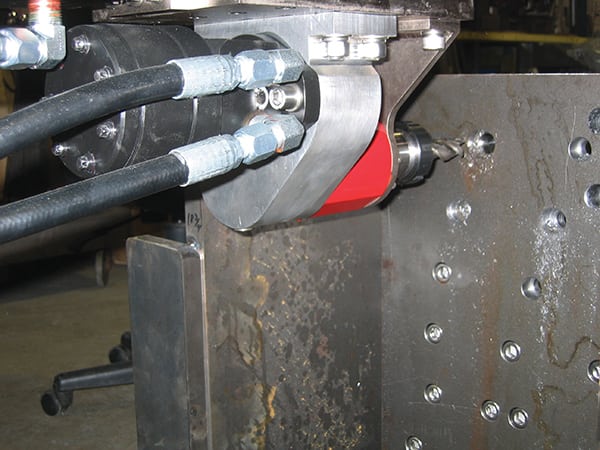 |
| 5. The bolt milling tool machine. After all the bolt heads/fasteners are milled, the baffle plates can be removed from the reactor vessel internals. Courtesy: PlantDecommissioning.com |
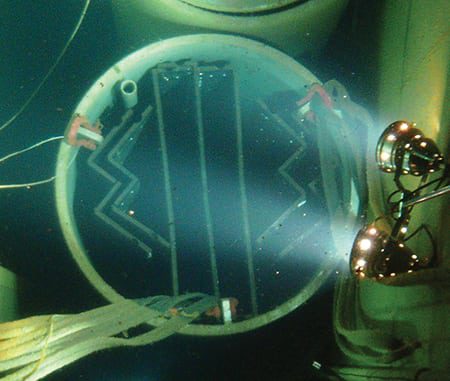 |
| 6. A greater-than-class C (GTCC) waste canister. The view is looking downward into a Unit 1 GTCC canister. Courtesy: Siempelkamp Nuclear Services |
Chromium is added to alloy steel to increase hardenability and corrosion resistance. Worker exposure to hexavalent chromium—an inhalation hazard—is possible during “hot work” cutting on stainless steel and other alloy steels containing chromium metal. In the past, when sizing the reactor coolant system using plasma torches, controlling this hazard required added ventilation controls, and medical monitoring for the workers was necessary. Although the cutting process is relatively quick, it is expensive because of all the controls that are required to be put in place. Because of this, Sauger said the project will be using wire saws when sizing the reactor coolant system piping. The abrasive wire saw is designed to cut reinforced concrete, steel, and other rigid materials of varying thicknesses using a high-speed rotating diamond-wire loop cable.
Reactor Vessel Segmentation
Another decommissioning first for the project will be RV segmentation. Past projects removed the RV in one piece, where it becomes its own shipping package. Certain radioactive waste disposal facilities have allowed the disposal of the entire pressurized-water RV with all of its internal components intact. Even with the high curie content, NRC disposal regulations allow averaging over the total weight of the RV assembly for waste classification. However, this is very expensive and a time-consuming process. At Zion, once the internals are removed, the RV will be sized into multiple pieces for shipment to Clive, Utah. Thermal cutting on the RVs is scheduled to begin in late 2014.
Because of their close proximity to the fuel core during operation, the RV and RVIs are the most activated components. These components and other waste items will be characterized as class A, B, C, or GTCC waste in accordance with 10 CFR 61, “Licensing Requirements for Land Disposal of Radioactive Waste.” These classifications are determined by both long- and short-lived radionuclide content (Table 1). Whereas class A, B, and C have increasing waste form stability requirements, GTCC waste is not acceptable for near-surface disposal and requires disposal in a geologic repository.
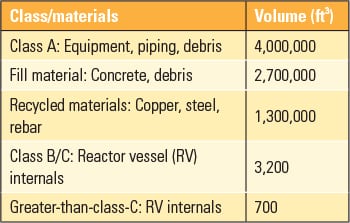 |
| Table 1. Types and estimated volumes of decommissioning wastes. Source: EnergySolutions |
The purpose of the internals segmentation projects is to separate those portions of the reactor that are GTCC waste from the remainder of the reactor. The GTCC components included the baffle assembly and the lower core support plate. These GTCC components contained 850,000 of the total 930,000 curies in each reactor (approximately 91% of the total activity). The baffle plates, with approximately 580,000 curies, represent most of the GTCC waste activity. The GTCC waste consists of about 44,000 pounds of activated metal.
The entire facility will be evaluated and measured for radioactive contamination. Any portion of the plant, including soil, that is contaminated and falls under the classification of class A concentration will be shipped to the EnergySolutions disposal site in Clive, Utah. Larger components, such as turbines, reactor vessels, and steam generators (all class A waste) from the Zion Station will also be packaged and shipped for disposal at Clive.
Whereas class A waste is being shipped off-site to Utah, class B and C wastes will eventually be sent to a facility that can dispose of those types of waste. GTCC waste will remain on site, stored at the ISFSI. The GTCC canisters being used are the NAC International MAGNASTOR TSC (transportable storage canister). While already in use for fuel storage, this is the first application for GTCC packaging.
Upcoming Work
ZionSolutions will be piloting its concrete demolition process starting in July 2014. The process will consist of razing the independent radioactive storage facility—the first concrete structure located inside the plant fence—and will include performing a final status survey. These processes will be tested on this smaller structure but will eventually be applied across the plant site. The clean fill materials, such as crushed concrete and building debris, will be used as backfill.
As radiological decommissioning work is completed and independently verified by the NRC, ZionSolutions will be working toward an end-state condition by:
■ Demolishing and removing clean equipment, buildings, and structures to 3 feet below grade.
■ Backfilling and stabilizing subsurface openings and excavated areas.
■ Grading and seeding the site to achieve a natural contour that blends in with the local environment.
■ Restoring the land—allowing for unrestricted/beneficial reuse of the site—in accordance with NRC criteria, with the exception of the ISFSI.
■ Keeping the ISFSI, switchyard, roads, rail, and fences in place.
■ Abandoning-in-place the lake intake and discharge piping.
■ Shipping all class A, B, and C waste off site.
■ Storing spent fuel and GTCC at the ISFSI.
■ Transferring the NRC license back to Exelon.
Sauger concluded that the project is going very smoothly from a stakeholder perspective, involving representatives from the state of Illinois, environmental groups, and the NRC. Everybody is working together to do the right things. It has been a smooth process, with a lot of back and forth between the stakeholders, but at the end of the day, good decisions are being made for the people of Illinois. ■
— James M. Hylko is a POWER contributing editor.


